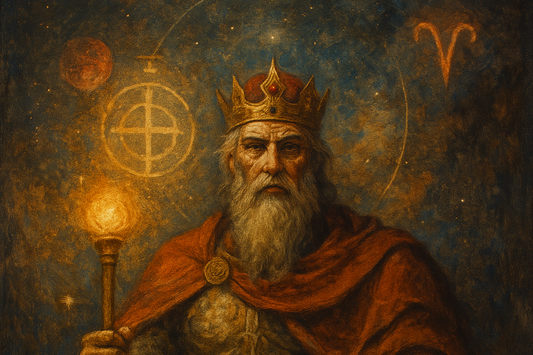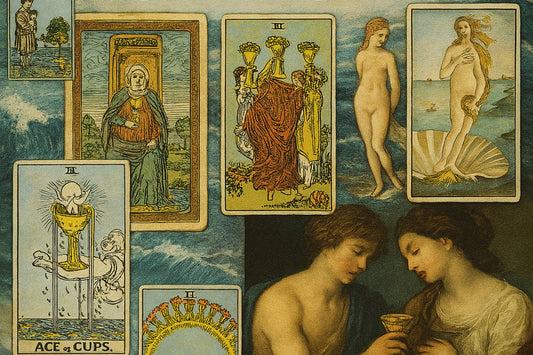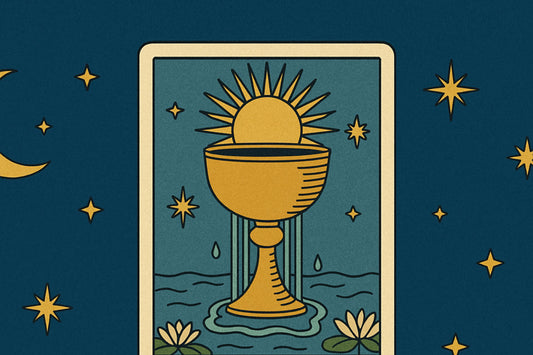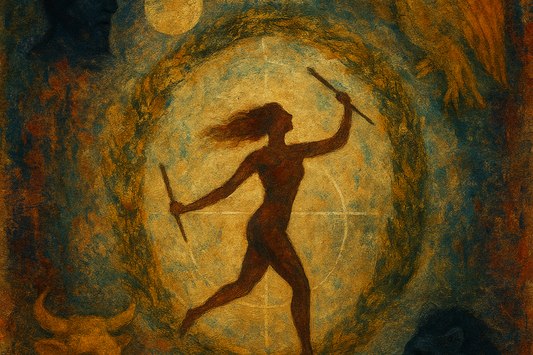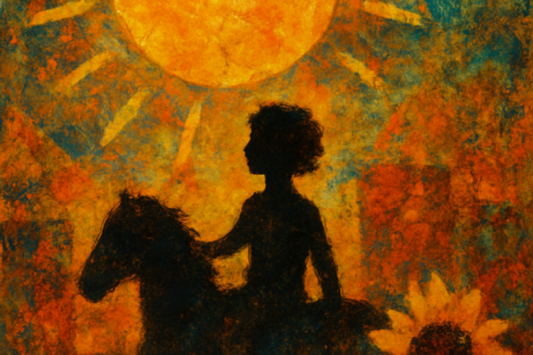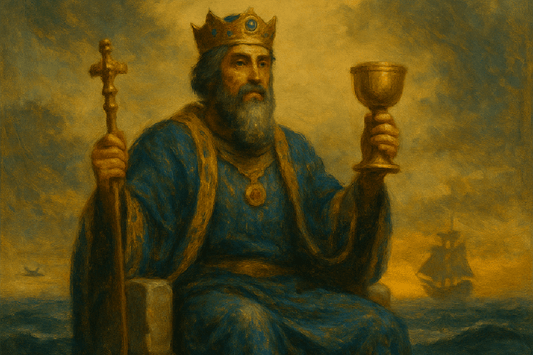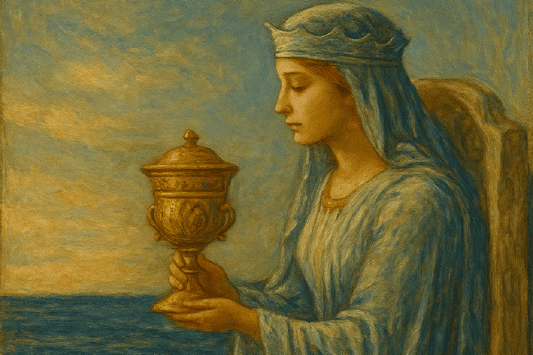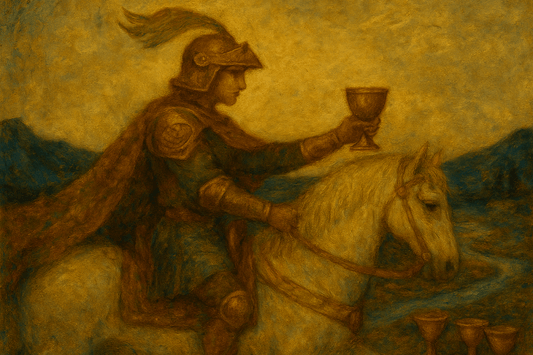The High Priestess in Tarot: Inner Knowing, Mystery and Sacred Stillness
Tarot AccessoriesTable of Contents
- TL;DR: The High Priestess Quick Reference
- The Archetype of the High Priestess in the Tarot
- Symbolism and Imagery of the High Priestess
- Meaning of the High Priestess in a Tarot Reading
- Reversed Meaning of the High Priestess in a Tarot Reading
- The Evolution of the High Priestess Throughout History
- Numerology and the Number Two in Tarot
- Astrological Resonance of the High Priestess
- Related Cards to Explore
- FAQs About the High Priestess in Tarot

TL;DR: The High Priestess Quick Reference
Upright: Intuition, silence, mystery, the unconscious, hidden knowledge, feminine wisdom, sacred stillness, liminality, receptivity, inner truth, dreams, veiled insight
Reversed: Disconnection from intuition, secrecy, confusion, repression, emotional withdrawal, denial, distorted femininity, silence weaponised, fear of knowing, spiritual bypassing
The Archetype of the High Priestess in the Tarot
The High Priestess sits where language ends. She is the space between question and answer, between inhale and exhale - between the pillars of what is known and what cannot yet be known.
She is the subconscious personified, the keeper of the temple's threshold. Her power is not in speech, but in what she withholds. She is intuition as an archetype - the part of you that already knows, but waits to speak until you are quiet enough to hear.
Following The Magician, who acts and manifests, the High Priestess retreats. She reflects.
Where He is will, She is receptivity.
She asks not "what can I do?" but "what do I already know beneath the noise?"
When the High Priestess appears in a reading, something unseen is moving. Something secret is surfacing. No one will name it for you. But if you’re quiet enough, you’ll hear her say it anyway.
Symbolism and Imagery of the High Priestess

The Rider-Waite-Smith depiction of the High Priestess is rich with deliberate stillness. She is seated between two pillars - marked B and J - Boaz and Jachin, the twin columns of Solomon’s Temple. This alone marks her as a guardian of sacred mystery.
She wears a blue robe like flowing water, echoing her link to the subconscious and emotional realm. The crescent moon at her feet is a clear call to the cyclical, inner tides of knowing - waxing, waning, returning. Behind her hangs a veil patterned with pomegranates, invoking both the Garden of Eden and Persephone’s descent into the underworld. It is the barrier between the seen and unseen worlds.
The scroll in her lap reads "TORA", partially hidden - reminding us that truth is always both revealed and concealed. Her crown, like the triple moon, aligns her with lunar cycles and the divine feminine.
Everything in the card says: this is not a space of action. This is a space of initiation.
Meaning of the High Priestess in a Tarot Reading
When the High Priestess shows up in a reading, it is an invitation to stop seeking answers outside of yourself. She is a portal inward - a call to pause, reflect, and listen to what lies beneath the surface.
This card can signal a time when silence is sacred. When observation matters more than intervention. It can mark the presence of a hidden influence, a spiritual guide, or an emotional truth waiting to emerge in its own time.
It often reflects a period of psychic sensitivity - a heightened sense of dreams, symbols, and gut feelings. The High Priestess does not tell you what is happening. She helps you recognise that you already know.
Reversed Meaning of the High Priestess in a Tarot Reading
Reversed, the High Priestess asks: what are you ignoring within yourself?
All the knowing is still there - it’s just being distorted, repressed, or drowned out. This may be a sign that you’re disconnected from your intuition, mistrusting your inner compass, or afraid of what your subconscious is trying to show you.
Sometimes, the reversal shows up as silence weaponised - secrets withheld, truths twisted, the feminine archetype distorted into coldness or manipulation. It can also represent spiritual bypassing - using spiritual language to avoid confronting real emotions.
In this position, the High Priestess reminds us that intuition is not soft. It is powerful, but only when we allow it to be honest.
The Evolution of the High Priestess Throughout History
In tarot history, the High Priestess has always been a charged figure and the archetype behind and inside of The High Priestess has always been veiled - mysterious, misinterpreted, and politically loaded. Her evolution across tarot history tells a story not just of symbolism, but of power: spiritual, feminine, and secret.
15th Century: La Papessa in the Visconti-Sforza Deck

The earliest visual representation of The High Priestess appears not as a mystic, but as La Papessa - The Female Pope.
In the Visconti-Sforza deck, she sits regally, dressed in papal robes, holding a closed book. This was a provocative image in 15th-century Italy, likely referencing the medieval legend of Pope Joan - a woman said to have disguised herself as a man to rise through the Church’s ranks.
This figure wasn’t a feminine mystic – she was a symbolic subversion. A threat to patriarchal religious authority. Some scholars also see her as a coded representation of the Church’s suppressed mystical traditions - a hidden lineage of female gnosis.
16th-17th Century: La Papesse in the Tarot de Marseille

In the Tarot de Marseille, The High Priestess remains as La Papesse. Still seated, still veiled, still holding her book. But the surrounding symbols begin to shift: the crescent moon becomes more prominent, her gaze more inward. She begins to represent not just heresy, but hidden wisdom - the mysteries withheld rather than denied.
This is where the archetype subtly transforms: from heretical figure to keeper of sacred knowledge. No longer just a question of gender or scandal - now a question of what cannot be known through reason alone.
The French Occult Revival of The High Priestess

The High Priestess was called that name for the first time in Antoine Court de Gébelin’s 1781 book - Le Monde Primitif where she was named La Grande-Prêtresse (The High Priestess).
Eliphas Levi, in his 1856 book Transcendental Magic, described The High Priestess as “a woman is crowned with a tiara, wearing the horns of the Moon and Isis, her head enveloped in a mantle, the solar cross on her breast, and holding a book on her knees, which she conceals with her mantel.”
It was also Levi that we can thank for associating The High Priestess with the Hebrew alphabet. Unlike the Golden Dawn after him, Levi attached the second letter Beth to The High Priestess - linking it with the House of God, solidifying the idea that The High Priestess is what's at the gates to the inside world.
The High Priestess in the Golden Dawn

The Hermetic Order of the Golden Dawn linked her to the Moon, the Qabalistic Tree of Life, and the Hebrew letter Gimel (the camel) - a symbol of the soul’s crossing through desert space.
She became associated with the path between Tiphareth (the Sun) and Kether (the Divine) - a liminal spiritual threshold. The High Priestess was no longer just the Church’s hidden counterpart. She was now the gateway to initiation, and the embodied wisdom of the inner world.
1909: The High Priestess in the Rider-Waite-Smith deck
Illustrated by Pamela Colman Smith, it’s the Rider-Waite-Smith deck we can thank for The High Priestess we know so well today.
She is no longer “The Popess.” She is The High Priestess - crowned with the lunar diadem, seated between Boaz and Jachin, the pillars of Solomon’s Temple. Behind her hangs a veil embroidered with pomegranates. In her lap, the scroll marked “TORA” - partially revealed, partially hidden.
Every detail signals: this is sacred ground. She is now the personification of the subconscious, of feminine knowing, of symbolic literacy and inner access. She is not to be explained - only entered.
This is the High Priestess archetype we recognise today: a being of quiet power, inner truth, and hidden gates.
The Present Day: High Priestess as a Living Archetype
Across modern decks and practices, The High Priestess continues to evolve - but always retains her essence.
She appears as oracles, witches, mystics, AI priestesses, moon maidens, data-holders, psychotherapists, and temple guards. Her form shifts - but her function is stable: to guard what must be earned, to whisper what is felt but not spoken.
Every time she’s drawn, the deck pauses.
Every time she appears, we are asked to go inward.
The High Priestess is here, as a living archetype in the collective consciousness of today, to hold our hand through the places we seldom tred.
Numerology and the Number Two in Tarot
The High Priestess expresses the Two in tarot not as division, but as sacred polarity. The High Priestess is the living tension between opposites. She holds polarity without trying to resolve it. The two is not a pause - it’s a chamber. A place of reflection before something sacred emerges.
In the Major Arcana sequence, she follows The Magician (1) - the singular initiator who leaps forth from The Fool (0) - and precedes The Empress (3) - the fertile expander. Two is the liminal moment between idea and creation, will and manifestation.
Emotionally, Two brings reflection. Spiritually, it’s a sacred pause. Energetically, it is magnetic receptivity.
The lesson of Two in numerology is to listen - not to the world, but to yourself. What’s waiting in the stillness?
Astrological Resonance of the High Priestess
The High Priestess is ruled by the Moon - the planet of intuition, memory, dreams, and the unconscious.
The Moon governs cycles, emotions, the tides - all of which mirror the energy of the High Priestess. She is lunar stillness. Her wisdom waxes and wanes. She teaches us not to fear what is hidden, but to trust what is felt.
There is also a strong tie with The High Priestess to Cancer, the Moon’s sign of domicile - protective, sensitive, inward, ancient.
Related Cards to Explore
The Suit of Cups in Tarot: 14 Ways of Feeling
Astrology of the Suit of Cups in Tarot: Planetary Meanings & Zodiac Correspondences
FAQs About the High Priestess in Tarot
What does the High Priestess mean in a love reading?
The High Priestess in a love reading signals depth, mystery, and emotional insight. It may suggest that more is going on beneath the surface than meets the eye. This could reflect a connection with deep spiritual or karmic undertones, or a situation that requires emotional patience and intuitive listening.
Is the High Priestess a yes or no card?
The High Priestess is a "not yet" card more than a yes or no. She suggests that the answer is hidden for now - not because it isn’t there, but because you are meant to discover it yourself. It advises patience, reflection, and trust in your inner process.
What does the High Priestess mean when reversed?
The High Priestess, when reversed, may suggest a period of internal dissonance - disconnection from your inner wisdom. It may signal blocked intuition, denial of your feelings, or a situation clouded by secrecy or avoidance. The reversal calls you to return inward and reclaim your emotional clarity.
What element is the High Priestess associated with?
She is associated with Water, the element of intuition, emotion, memory and mysticism. Water flows quietly - like her. It reaches depths without force.
What archetype does the High Priestess represent?
The High Priestess is the archetype of the mystic, the seer, and the inner oracle. She exists in every psyche as the part that sees without looking, knows without explanation, and waits - not for answers, but for you to stop needing them.


